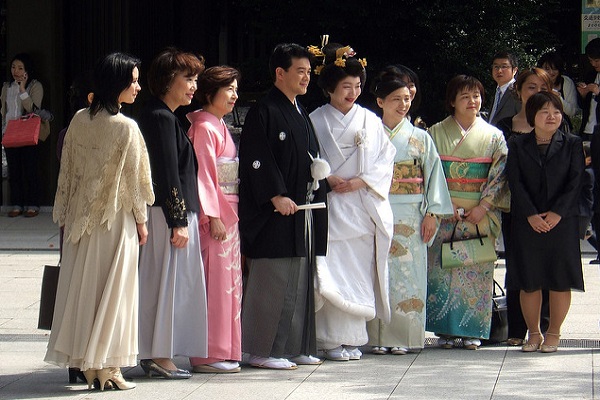
What are the Traditions of a Shinto Wedding?
- By Kelly Frazier --
- 30 May 2017 --

Rituals of a Shinto wedding
A Shinto wedding is a traditional union ceremony that occurs in Japan. Just like in Christian weddings, couples confess their love for each other. They also pledge their loyalty to one another and pledge their undying love at shrines with Japanese gods known as Yaoyorozu.
What are the traditions of a Shinto wedding?[/tweetthis]
Started more than five centuries ago, Shinto weddings have been practiced since the Muromachi period.[/tweetit] Initially, couples would get married in a zashiki which was a sitting room with an alcove. However, customs changed, and weddings began to be conducted in front of a shrine dedicated to the Sun Goddess Amaterasu Oomikami. They follow the rituals below throughout the ceremony.
Before the ceremony begins, the bride and groom are usually situated in a waiting room. Once the wedding is about to commence, the couple walks into the shrine, a process traditionally called sanshin. Some processions into the shrine involve the couple to be wedded walking in line with the Shinto priests. As they walk in, they are accompanied by the shrine maiden who carries a red umbrella. Those attending the wedding then sit in the shrine, a custom termed as Haiden chakuza. The sitting arrangement places the couple closest to the god. From the god’s side, the groom sits on the right, and the bride sits on the left.
Afterward, the priests can then purify the bride and groom before they can be married. This custom occurs in a ritual known as Shubatsu. The rest of the ceremony is then ready to begin, kicked off by Saishu ichirei. This is the wedding’s official beginning. Everyone in the shrine bows down to the gods. The Shinto priest, normally known as Kensen, gives the couple an offering that they present to the gods. In this way, they are welcomed into the shrine.
During Norito soujo, the priest reads the “Nourito” aloud. This is a document that promises the couple never-ending happiness and explains that they will be married from that day on. After the pledge, the couples take a sacred vow by drinking sacred sake from the same glass. This ritual is known as Sankon no gi. The bride drinks from the glass first, followed by the groom.
After making the vow to each other, either the bride or groom make a vow to the gods about their marriage in a ritual known as Seishi soujo. Sometimes, both of them make the vow. The shrine maiden then dances so as to please the gods and gain favor for the newly-wedded couple. As a show of sincerity to the gods, the couple offers Tamagushi, a special branch of Japanese Cleyera. It is ornately decorated with a stream of zigzag paper known as Shide and cotton thread. They then bow down to the god twice, clap two times and bow a final time as a show of gratitude to the god.
We arrived at the Yasaka Shrine just in time to view a Shinto wedding procession. #Shrine… https://t.co/FGl7NrgUSi
— Karen Turner (@TheKarenT) May 28, 2017
To create a tie between both families, each family member drinks sacred sake from their glass. This ritual, Shinzoku sakazsuki no gi, develops a strong bond between all who drink the sake.
Finally, the priest takes the offerings that the couple made at the ceremony’s beginning. They are now treasured since the newly-wedded couple is believed to have strong power from the gods upon marriage. In conclusion, Saishu ippai occurs. Everyone in attendance bows down to the god and the marriage is consummated.


















